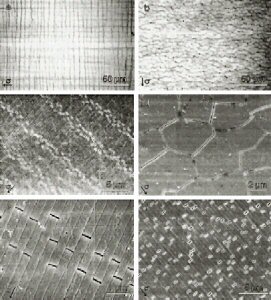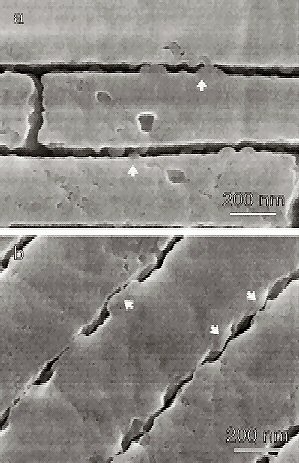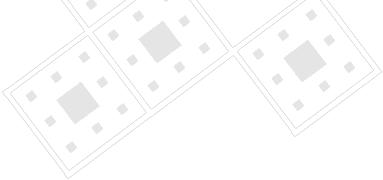Research: Deformation Mechanisms in Nacre
Rizhi Wang
In collaboration with Zhigang Suo, Harvard University, and
Anthony G. Evans, UCSB
Nacre (mother-of-pearl), the pearly internal layer of many mollusc shells, was addressed in this study.[1] Many biological materials exhibit structural robustness, despite the brittle nature of their constituents. Well known examples include bone, teeth, and mollusc shells.[2–4] Nacre comprises about 95% aragonite (a mineral form of CaCO3), with only a few percent of biological macromolecules, yet its work of fracture is about 3 orders of magnitude higher than monolithic ceramics,[5,6] and its strength is among the highest in shell structures.[7] A thorough understanding of the mechanisms underlying this robustness could inspire new ideas in material design and synthesis. The goal of this study, in conjunction with a companion theoretical analysis,[8] was to elucidate the basic mechanisms.
As elaborated elsewhere,[9,10] good toughness is a necessary but not sufficient requirement for structural utility. The more basic prerequisite is a deformation mechanism that permits the material to exhibit inelastic strain when loaded in tension and shear. The basic idea is that (when sufficiently large, relative to elastic strains) this inelastic deformation allows the material to redistribute stress around strain concentration sites, thereby eliminating stress concentrations and, consequently, rendering the material “notch insensitive. Absent this strain capacity, materials are susceptible to unpredictable failures from imperfections.

White tension lines (or dilatation bands) at various magnifications: (a) abalone, edge-on, optical microscopy (OM), vertical bands; (b) pearl oyster, face-on, OM, horizontal bands; (c) abalone, edge-on, SEM showing four oblique dilatation bands; (d) pearl oyster, face-on, SEM, oblique bands; (e) abalone, edge-on, SEM showing one dilatation band from upper left to lower right; (f ) pearl oyster, edge-on, SEM. Arrows indicate the orientation of tensile stress.[1]
Nacre exhibits inelastic deformation in both shear and tension. The strain in shear parallel to aragonite plates is as high as 8% and at least 1% upon loading in tension axial to plates. In compression, it is linear elastic to failure. Deformation in shear occurs by interlamellae slip and in the tension by the formation of multiple dilatation bands at intertablet boundaries accompanied by interlamellae sliding.

Cross section of abalone nacre showing the detailed structure at the lamellae boundaries. Arrows highlight locations where the nanoasperities interpose.[1]
The stress at which the inelastic deformation proceeds is governed by nano-sized mineral asperities on the surface of the aragonite tablets. Their interposing arrangements between neighboring lamellae dictate the sliding resistance subject to an initial strain hardening that facilitates the observed ductility.[8] The inelasticity imparts mechanical robustness by allowing redistribution of stress around strain concentration sites. Nacre thus presents a model structure for designing a robust laminated ceramic. Precise design of interfacial morphology at the nanoscale to control interlamellae slip appears to be the first step toward a ceramic laminate that exhibits tensile ductility. An organic interlayer that retains transverse integrity during slip provides a second requirement.
References
1. R.Z. Wang, Z. Suo, A.G. Evans, N. Yao, I.A. Aksay J. Mater. Res. 16 [9] 2485-93 (2001).
2. S. Weiner and H.D. Wagner Annu. Rev. Mater. Sci. 28 271 (1998).
3. S. Weiner and L. Addadi J. Mater. Chem. 7 689 (1997).
4. The Mechanical Properties of Biological Materials, edited by J.D. Currey and J.F.V. Vincent (Cambridge University Press, Cambridge, United Kingdom, 1980).
5. A.P. Jackson, J.F.V. Vincent, R.M. Turner Proc. R. Soc. London, Ser. B 234 415 (1988).
6. J.D. Currey Proc. R. Soc. London, Ser. B 196 443 (1977).
7. J.D. Currey J. Zool. London 180 445 (1976).
8. A.G. Evans, R.Z. Wang, Z. Suo, I.A. Aksay, M.Y. He, J.W. Hutchinson J. Mater. Res. 16 [9] 2475-84 (2001).
9. A.G. Evans and F.W. Zok Solid State Phys. 47 177 (1994).
10. A.G. Evans, Acta Mater. 45 23 (1997).
For more information, please contact Ilhan Aksay. See the Ceramic Materials Laboratory web page for more information about our group and its research.
![]()
![]()
![]() © 2004 Princeton University, Ceramic Materials Laboratory.All Rights Reserved.
© 2004 Princeton University, Ceramic Materials Laboratory.All Rights Reserved.


